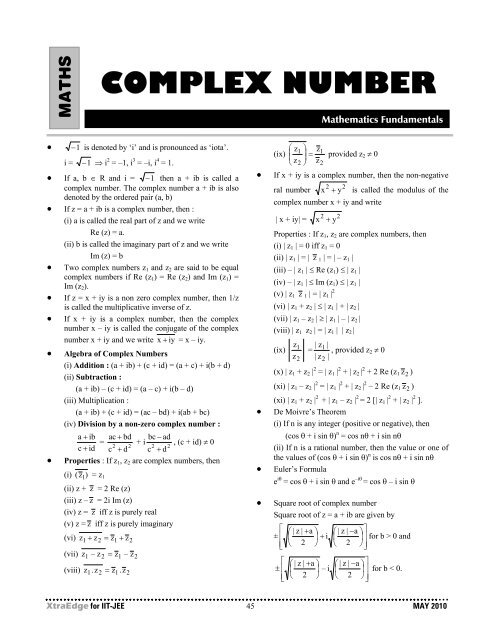Create successful ePaper yourself
Turn your PDF publications into a flip-book with our unique Google optimized e-Paper software.
MATHS<br />
COMPLEX NUMBER<br />
Mathematics Fundamentals<br />
− 1 is denoted by ‘i’ and is pronounced as ‘iota’.<br />
i = − 1 ⇒ i 2 = –1, i 3 = –i, i 4 = 1.<br />
If a, b ∈ R and i = − 1 then a + ib is called a<br />
complex number. The complex number a + ib is also<br />
denoted by the ordered pair (a, b)<br />
If z = a + ib is a complex number, then :<br />
(i) a is called the real part of z and we write<br />
Re (z) = a.<br />
(ii) b is called the imaginary part of z and we write<br />
Im (z) = b<br />
Two complex numbers z 1 and z 2 are said to be equal<br />
complex numbers if Re (z 1 ) = Re (z 2 ) and Im (z 1 ) =<br />
Im (z 2 ).<br />
If z = x + iy is a non zero complex number, then 1/z<br />
is called the multiplicative inverse of z.<br />
If x + iy is a complex number, then the complex<br />
number x – iy is called the conjugate of the complex<br />
number x + iy and we write x + iy = x – iy.<br />
Algebra of Complex Numbers<br />
(i) Addition : (a + ib) + (c + id) = (a + c) + i(b + d)<br />
(ii) Subtraction :<br />
(a + ib) – (c + id) = (a – c) + i(b – d)<br />
(iii) Multiplication :<br />
(a + ib) + (c + id) = (ac – bd) + i(ab + bc)<br />
(iv) Division by a non-zero complex number :<br />
a + ib ac + bd bc − ad<br />
= + i , (c + id) ≠ 0<br />
2 2 2 2<br />
c + id c + d c + d<br />
Properties : If z 1 , z 2 are complex numbers, then<br />
(i) ( z 1 ) = z 1<br />
(ii) z + z = 2 Re (z)<br />
(iii) z – z = 2i Im (z)<br />
(iv) z = z iff z is purely real<br />
(v) z = z iff z is purely imaginary<br />
(vi) z 1 + z2<br />
= z1<br />
+ z2<br />
(vii) z 1 – z2<br />
= z1<br />
– z2<br />
(viii) z 1 .z2<br />
= z1<br />
. z2<br />
⎛ z<br />
(ix)<br />
⎜<br />
⎝ z<br />
1<br />
2<br />
⎞<br />
⎟ =<br />
⎠<br />
z1<br />
z2<br />
provided z 2 ≠ 0<br />
If x + iy is a complex number, then the non-negative<br />
2 2<br />
ral number x + y is called the modulus of the<br />
complex number x + iy and write<br />
| x + iy| =<br />
2 2<br />
x + y<br />
Properties : If z 1 , z 2 are complex numbers, then<br />
(i) | z 1 | = 0 iff z 1 = 0<br />
(ii) | z 1 | = | z 1 | = | – z 1 |<br />
(iii) – | z 1 | ≤ Re (z 1 ) ≤ | z 1 |<br />
(iv) – | z 1 | ≤ Im (z 1 ) ≤ | z 1 |<br />
(v) | z 1 z 1 | = | z 1 | 2<br />
(vi) | z 1 + z 2 | ≤ | z 1 | + | z 2 |<br />
(vii) | z 1 – z 2 | ≥ | z 1 | – | z 2 |<br />
(viii) | z 1 z 2 | = | z 1 | | z 2 |<br />
z1<br />
| z<br />
(ix) =<br />
1 |<br />
, provided z 2 ≠ 0<br />
z2<br />
| z2<br />
|<br />
(x) | z 1 + z 2 | 2 = | z 1 | 2 + | z 2 | 2 + 2 Re (z 1 z 2 )<br />
(xi) | z 1 – z 2 | 2 = | z 1 | 2 + | z 2 | 2 – 2 Re (z 1 z 2 )<br />
(xi) | z 1 + z 2 | 2 + | z 1 – z 2 | 2 = 2 [| z 1 | 2 + | z 2 | 2 ].<br />
De Moivre’s Theorem<br />
(i) If n is any integer (positive or negative), then<br />
(cos θ + i sin θ) n = cos nθ + i sin nθ<br />
(ii) If n is a rational number, then the value or one of<br />
the values of (cos θ + i sin θ) n is cos nθ + i sin nθ<br />
Euler’s Formula<br />
e iθ = cos θ + i sin θ and e –iθ = cos θ – i sin θ<br />
Square root of complex number<br />
Square root of z = a + ib are given by<br />
⎡<br />
± ⎢<br />
⎢⎣<br />
⎡<br />
± ⎢<br />
⎢⎣<br />
⎛ | z | + a ⎞<br />
⎜ ⎟ + i<br />
⎝ 2 ⎠<br />
⎛ | z | +<br />
⎜<br />
⎝ 2<br />
a<br />
⎞<br />
⎟<br />
⎠<br />
⎛ | z | −a<br />
⎞⎤<br />
⎜ ⎟⎥<br />
for b > 0 and<br />
⎝ 2 ⎠⎥⎦<br />
⎛ | z | −a<br />
⎞⎤<br />
– i ⎜ ⎟⎥<br />
for b < 0.<br />
⎝ 2 ⎠⎥⎦<br />
XtraEdge for <strong>IIT</strong>-<strong>JEE</strong> 45 MAY 2010

















